Physical Address
Suite 5, 181 High Street,
Willoughby North NSW 2068
Physical Address
Suite 5, 181 High Street,
Willoughby North NSW 2068
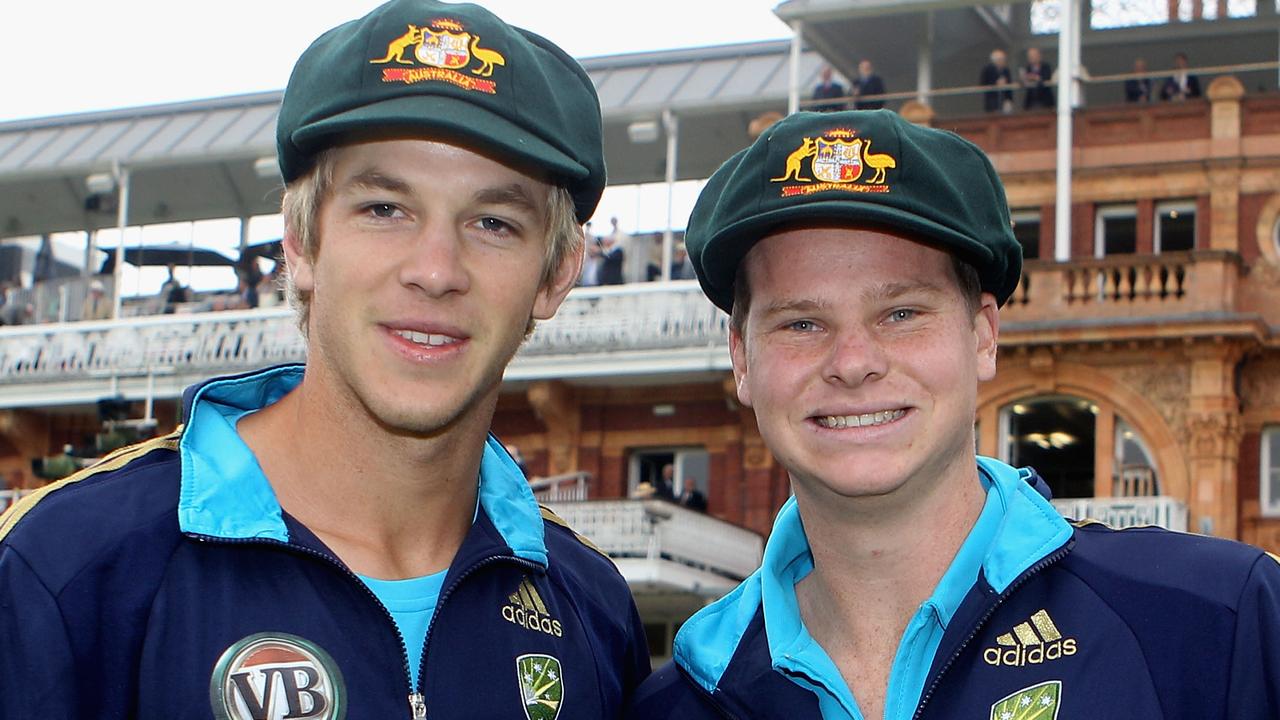
Smith reaches HISTORIC 10,000 Test runs! | 00:44
Having long walked among the giants of cricket, Steve Smith has — after a painful wait on 9,999 runs — cemented his Test immortality with one of the most special milestones the game has to offer.
Watch every ball of The 2025 Women’s Ashes Series LIVE with no ad-breaks during play on Kayo | New to Kayo? Get your first month for just $1. Limited time offer.
With a flurry to mid-on and a quick dart to the non-striker’s end, the 35-year-old joined legends Ricky Ponting, Steve Waugh and Allan Border as the only Australians to accumulate more than 10,000 runs in Test cricket.
It is a mark achieved by only the best to wield the willow, a milestone that is a testament to those freakishly gifted with the bat and also to their mental strength and physical durability.
From Sachin Tendulkar to Brian Lara, Jacques Kallis to Sunhil Gavaskar, and now the Australian quartet, the club of 15 is resplendent for the quality of its craftsmen and a testament to their longevity in the sport.
Smith, who is in his 15th season as an international cricketer, is as worthy of a spot among the 10,000 run men as any given his batting brilliance and ability to overcome adversity.
The New South Welshman has dealt with queries about his technique from his opening ball. He has been dropped, endured lean spells, suspended and shamed. Yet he has prevailed, with the milestone coming against Sri Lanka on day one in Galle.
For all of Smith’s crabbing across the crease and the fidgeting as he prepares to face, the Australian has continued to flourish into his mid-30s with an insatiable appetite for runs.
Not that Smith will worry too much about the fabulous feat. As he told foxsports.com.au in an extended chat last year; “Maybe one day I’ll pull them out and look back on them and think differently, but right now, I’ve never been one to play for personal sort of accolades.”
“I’ve always wanted to just go out and do my best and help whichever team I’m playing with have success and that has been it for me,” he said.
Fellow champions have no doubt about how deserving Smith is of his place in the sun among the stars.
Adam Gilchrist calls him the “master craftsman”. Michael Vaughan noted he is among the few to “be talked about like Don Bradman”. Mark Waugh has no doubt Smith would have excelled in any era. Kerry O’Keeffe has him at No.3 in his best Australian team.
As for the assessment from his old teammate David Warner? Smith is “a rare cat with an extraordinary cricket brain” and it is “no fluke” that he has become an enduring champion.
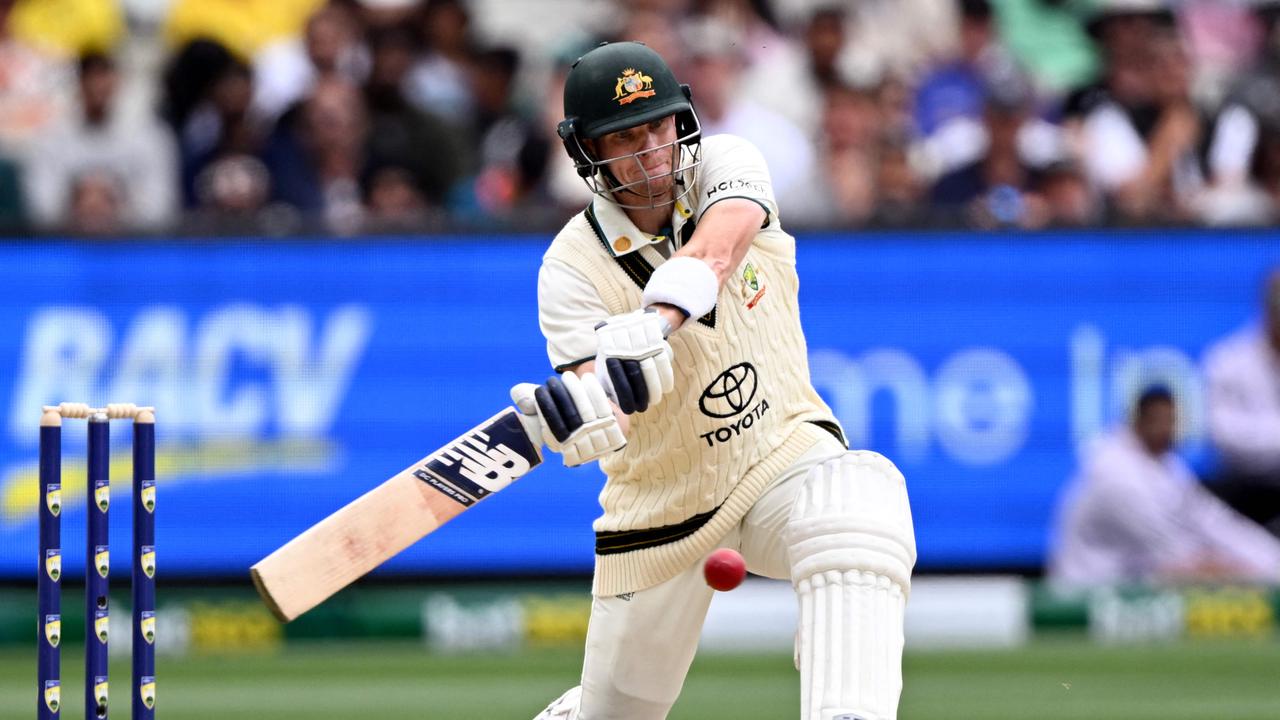 Australia’s Steve Smith on the path to a century at the MCG in the Boxing Day Test in 2024.Source: AFP
Australia’s Steve Smith on the path to a century at the MCG in the Boxing Day Test in 2024.Source: AFPWEAVING WEBS AND SPINNING YARNS WITH A LEGEND
Gilchrist, an iconic Australian cricketer, still shakes his head at the evolution of Smith from his introduction into the national team to his status as “the best since Bradman”.
Australia was scouring its ranks for a successor to Shane Warne when the blond kid, who was born in the south Sydney suburb of Kogarah, was introduced as a spinning all rounder in 2010.
A couple of astute observers watched the fledgling talent representing NSW with interest, noting just how similar Smith’s body language at the top of his mark was to Warne, though not necessarily his ability to land the ball on a cigarette butt on a whim like the Victorian.
Smith had spent time with the legendary spinner in the MCG nets prior to his Test career and spoke about how Warne advised him to “keep trying to spin the ball and to turn it hard”.
“I used to watch him all the time on TV and he was a genius at the art of leg-spin bowling and I have learnt a lot from him over the past couple of weeks,” Smith said in an interview.
“(He taught me) a little bit of everything, about being patient, slowing my run-up, getting my shoulder up a bit higher, that sort of thing.
“It was pretty exciting to be bowling with the King and learning from him. He was such a genius and the art of leg-spin bowling, to be having a few sessions with him, it was amazing.”
The future Australian captain’s first Test was at Lord’s, though not against England, with the United Kingdom used as neutral territory for a series against Pakistan in 2010.
He snared three wickets but only 13 runs at the iconic ground, which was scarcely a pointer that Australia had unearthed a generational talent who would prove a matchwinner.
“I think part of what is so amazing is how it started and how he got into the team at 8 or 9 bowling leg spin, when we were still in the hunt for a replacement for Warnie, and (there were questions as to) where he was going to be that option? That is what I find quite stunning about his career, how it started,” Gilchrist said.
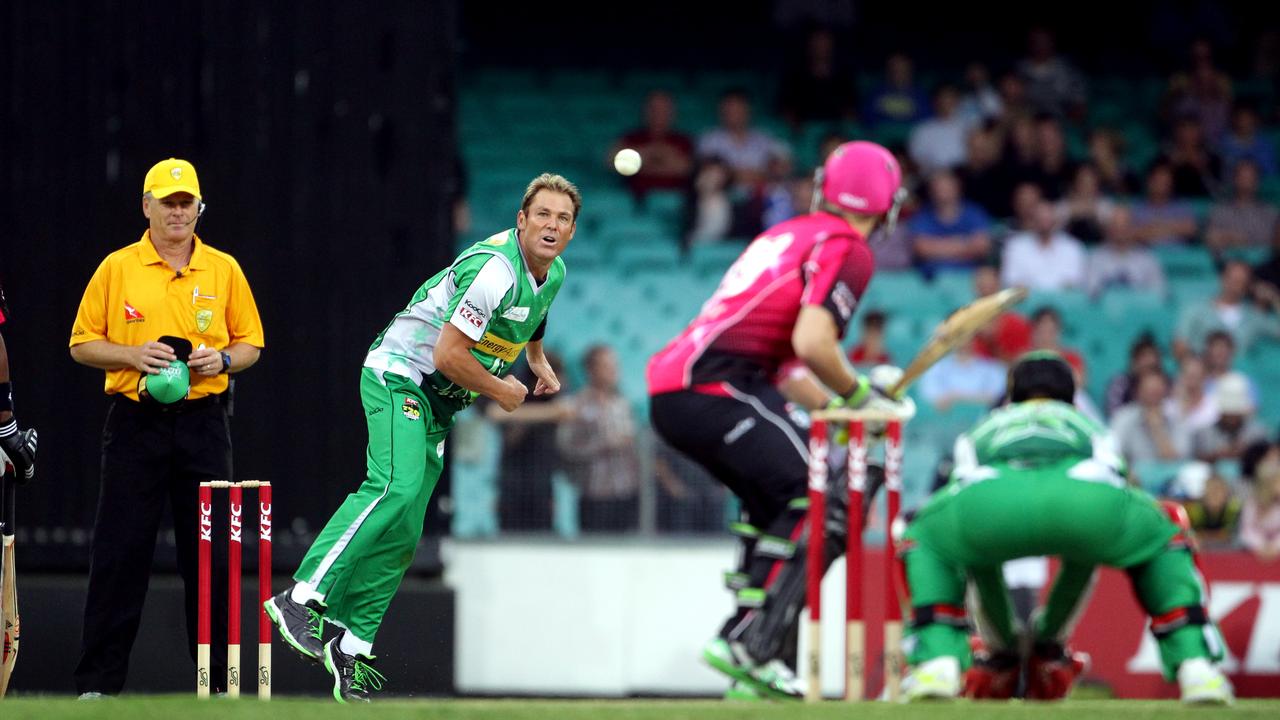 Steve Smith facing up to an old mentor in Shane Warne in a BBL match at the SCG.Source: News Limited
Steve Smith facing up to an old mentor in Shane Warne in a BBL match at the SCG.Source: News LimitedAs a former Australian spinner, O’Keeffe had taken note of Smith as a teenager and watched him bowling wrist spinners in the nets as he worked through the ranks in Sydney.
He was far from convinced Australia had found the second coming of Warne with the ball but felt the newcomer could prove a highly productive cricketer with the bat instead.
“I’ve never seen the like. I remember Steve Smith when he was a teenager and he bowled these wristy leg spinners with a flawed action. His mechanics, he admitted, weren’t great. He just had to time the release. And some were jaffas and some were filth,” O’Keeffe said.
“But then somebody said, ‘Now you’ve bowled a few Steve, do you want to have a hit?’. He said, ‘Yeah, I’ll have a hit.’ And then I saw what he did with that hand-eye coordination and I thought, ‘Nup. He bats’.
“And I know when he first went out for Australia in England, I was doing ABC Radio and he hit a lot of fours in the losing cause, and they said, ‘He is not much of a leggy, but he is a useful late order hitter,’. I said, ‘I think he’s better than that.’
“Not that I’m boasting, but I just saw he had a capacity to hit boundaries from impossible positions that only the greats can, such was his hand eye co-ordination. And he could read bowlers.”
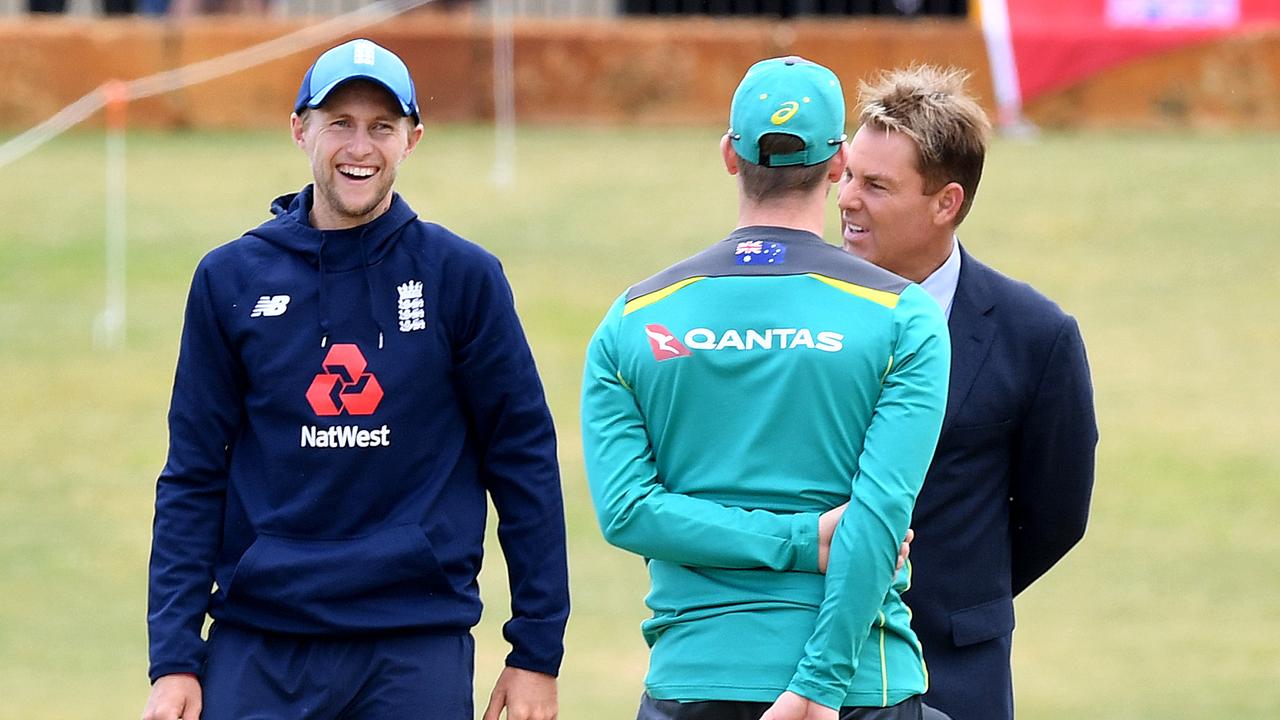 Steve Smith chatting with fellow star Joe Root and Shane Warne at the WACA in 2017.Source: AAP
Steve Smith chatting with fellow star Joe Root and Shane Warne at the WACA in 2017.Source: AAPTHE IMPORTANCE OF STAYING GROUNDED
Smith, who credits a stint with the Sevenoaks Cricket Club in Kent as a 17-year-old as an experience that helped him mature, continued to impress more with the bat than the ball.
Half-centuries against Pakistan at Leeds and England at the SCG at the start of 2011, along with a couple of 30s, suggested O’Keeffe’s initial assessment of him was spot on.
It was when returning to the Australian team for a tour in India in 2013 where he was taught a lesson that has stayed with him through from his 300th run in Mohali to the 10,000 run milestone.
On his recall to the Australian team, Smith reached 92, only to be stumped by MS Dhoni when beaten by a delivery from Pragjan Ohya. He was filthy but it was a worthwhile lesson.
“It was a big learning curve that day,” he said.
“I got out stumped, lunging at a ball, and my foot dragged, so now when I face a ball that is spinning away consistently, I’m bringing my stance back slightly so that when I land and I drag my foot, it’s always in the crease.”
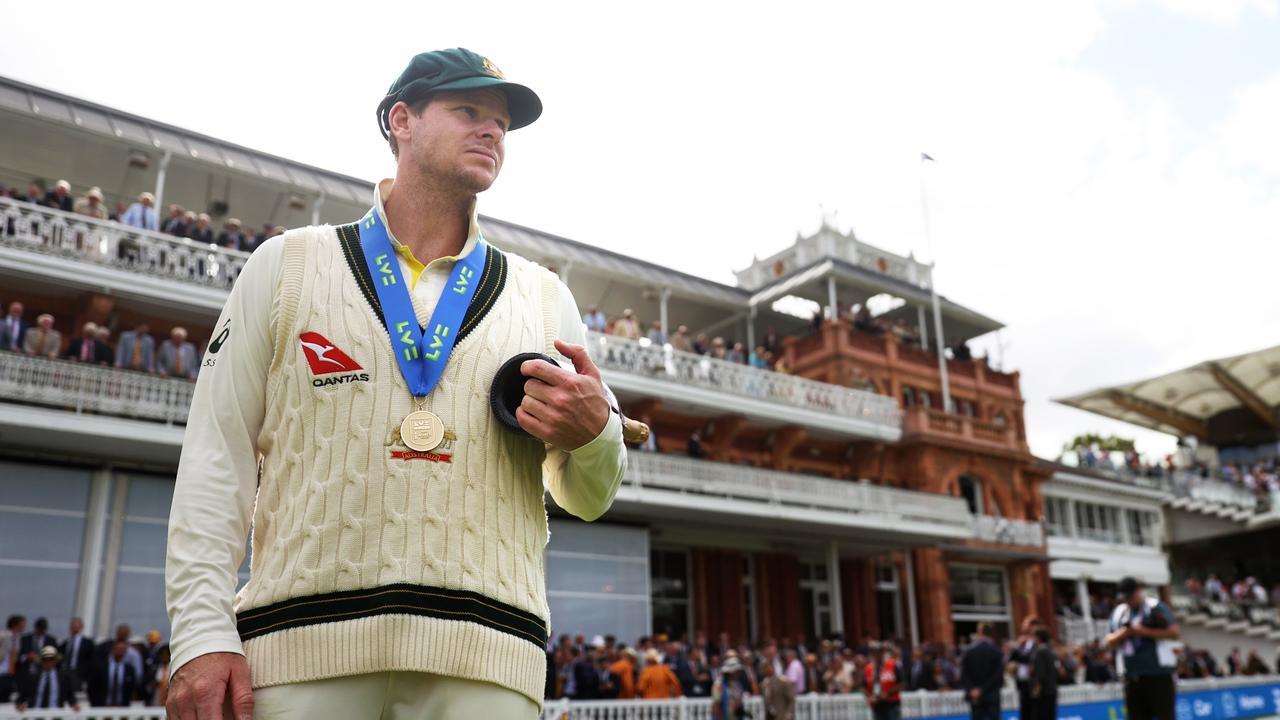 Steve Smith at Lord’s in 2023.Source: Getty Images
Steve Smith at Lord’s in 2023.Source: Getty ImagesIt was on the tour of India that Smith’s decision to make his batting a priority first came to the fore.
He had already come to the realisation that while he could be a handy part-time option, the flaw O’Keeffe had noted years earlier in the nets was one that would be hard to rectify.
“That was my first real opportunity to play since I’d gotten rid of my bowling,” Smith said.
“I had come to terms with that in the two years leading up, (pondering) ‘What is my best way to get back into the Australian team? And I felt as though getting rid of my bowling and focusing on my batting was that.”
Smith worked especially hard on his footwork in the nets against spinners leading into his recall and has never looked back, with his dancing against Ravindra Jadeja and Washington Sundar at the MCG when scoring his 34th Test century masterful.
“He was born a cricketer, and I’ve seen him take spinners apart in the nets when I had something to do with developing spinners, and he just crucified them,” O’Keeffe said.
“He ran at them, he went back, he played with their heads. And I said ‘This bloke, I don’t know what he’ll end up averaging in Test cricket, but he’s going to slaughter some slow bowlers over the years’. And so it’s come to pass.”
His former teammate Warner said the discipline with which Smith has approached his craft goes a long way to explaining his sustained success with the willow.
“He is an absolutely amazing cricket player and he just works hard. He literally has cricket ball sandwiches,” Warner said.
“Early in his career he would be the first in the nets and the last in the nets. You just knew when Steve was hitting a lot of balls, he was on. It is not by fluke that he is still playing.
“His tenacity to bat long periods of time and get himself in and score runs for the team is amazing. Being up the other end and watching him do it with ease and have so much time, you then go back and (think), ‘If I hit that many balls, would I have that much time?’. I don’t think so. But it is his natural knack and ability to do that and churn our hundreds for fun and lots of runs for Australia.”
THE FUSE IS LIT
The first century proved elusive, with Smith falling narrowly shy in Manchester in the third Test of the 2013 Ashes tour when falling for 89. It was one, he said, that “he threw away”.
But in his 12th Test match for Australia, the drought broke when he made an unbeaten 138 at The Oval with a mentor at NSW in Brad Haddin providing guidance in the nervous 90s.
Smith, finally, was away. And in a return bout at the WACA a few months later, he scored another century to demonstrate that he had the temperament to succeed in the long term.
“(It was) my first 100 at home (and it came in) precious sort of circumstances. The Ashes were there to be won. We were up two-nil but we were in a bit of trouble,” he said.
“That innings was one where I gained a lot of confidence … coming up against guys like Stuart Broad and Jimmy Anderson, who had played a lot of cricket at that stage.
“They were quality Test bowlers, so to be able to get 100 against them also gave me a lot of confidence, especially (when getting) my first 100 in Australia.”
Mark Waugh, who was an Australian selector through the period where Smith began his ascension to superstar status, took a shine to his excellence in the slips.
As a testament to that skill, “Smudge” will soon pass Ponting’s record of 196 catches in the field.
But in a recent chat at the MCG, Waugh said he also appreciated Smith’s hunger for runs, as evidenced in both his frustration when getting out and also in his ability to knuckle down.
“He is very unorthodox. You watch him bat and think, ‘How does he do it?’ But he finds a way,” Waugh said.
“He is a very, very smart cricketer who adapts to situations better than any player I have seen. He can play pace bowling. He can play spin. He can accelerate but also dig in when called to. He reads the game so well. And he is so hungry for runs.
“Once he gets in, he is not happy with 110 or 120. He wants to make a double-century. He has got that hunger and he still has it now.”
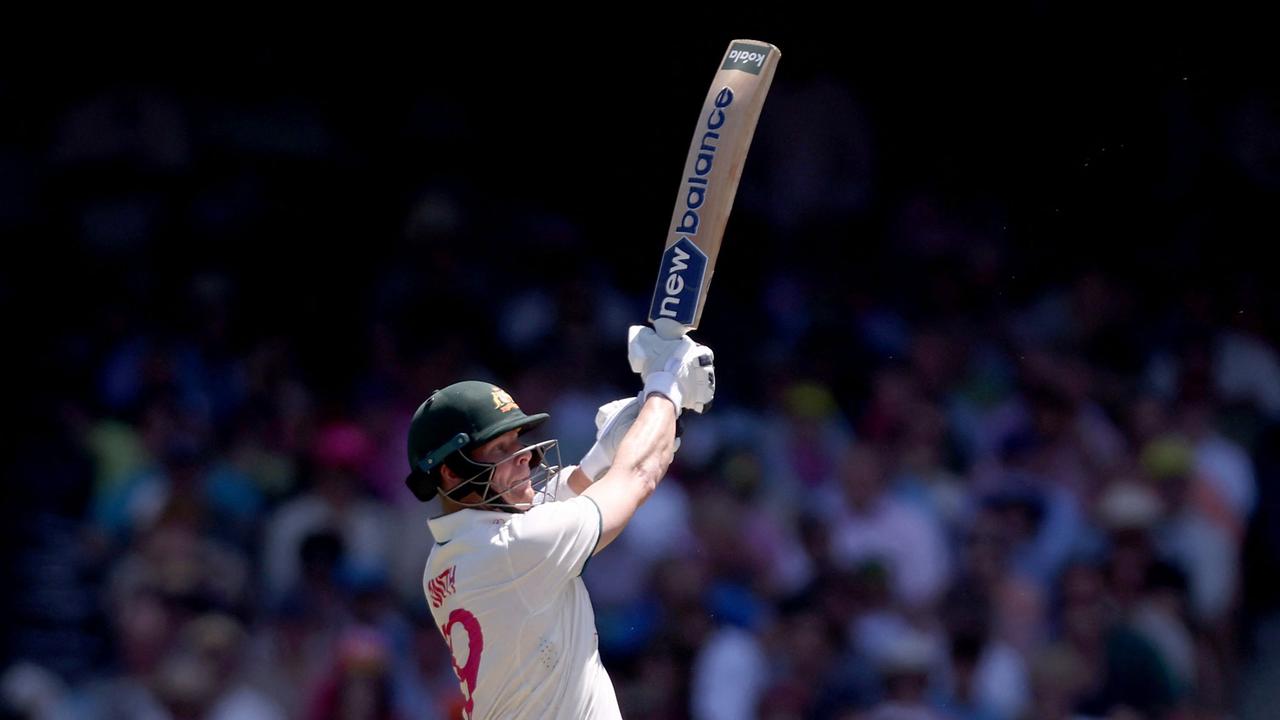 Smith hits a boundary during day two of the fifth Test match between Australia and India at The SCG.Source: AFP
Smith hits a boundary during day two of the fifth Test match between Australia and India at The SCG.Source: AFPTHE VIEW FROM ABROAD
It would be fair to say that the bigger the stage, the better Smith performs, as his records against Australia’s biggest rivals England and India demonstrate.
A dozen of his 34 Test centuries have come against England. He has also snared 11 against India, the most recent the scrapping century at the Gabba and then a sublime MCG knock in this series.
Of his 113 Tests to date, 61 have come against India and England, and he has scored almost 6,000 of his runs against them as well.
Vaughan, the former English captain, said his ability to perform in the most high-profile series added lustre to his record given he has batted on Broadway for much of his career.
“I would argue that he is the best modern day Test match player,” Vaughan said.
“I think he is the best problem solver. He has a quirky technique but he just seems to be able to pick the ball out of the hand of the bowlers quicker than most. He has this amazing ability to study the field and work out what is on and what is not on any given day on a pitch.
“If you look at his numbers, there are only a small few who have got close to being talked about like Don Bradman. And when you are in a conversation when the Don is involved, you know you are pretty good.”
Former Indian coach Ravi Shastri said Smith’s ability to improvise and score in any conditions was a factor that made him an all-time great.
“I’ve seen all these hundreds as a coach and as a broadcaster and he’s a special player. He’s so passionate about the game,” Shastri said.
“What amazes me is how he’s prepared to adapt to different conditions. He got a hundred on a rank turner in India, which was special. And even when he’s not at his best, he finds ways to get into positions to score runs.
“When you’re around for that length of time, there are teams analysing you, there are video analysts looking at every part of your technique. And then to still be able to be ahead of the curve — and he will average over 55 — at the age of 35, to go past 10,000 runs is special. So I think he’s a great player.”
Prominent Indian broadcaster Harsha Bhogle said that Smith’s deeds against his nation in big matches such as the World Test Championship Final and World Cups had earned him respect across the subcontinental nation.
“He is widely respected, as you’d imagine, for someone who’s got so many hundreds against India and on big stages. He’s got far too many runs against India, so everyone in India has a lot of respect,” Bhogle said.
“He is very different from any of the other Aussies who’ve got to score big runs. If you look at the ones in recent times, the Pontings, the Clarks, the Waughs and the Haydens, they all had their own style, but they were within the realms of orthodoxy.
“Steve Smith with his quirks, you look at him bad and you think, ‘Nah, this guy can’t make 9000 runs.’ But he’s doing something right. He might look quirky, but he’s in good positions to score runs. If he wasn’t in good positions to score runs, he wouldn’t be one of the legends of our game.
“People talk about him having a bad patch. When you have a bad patch, and you come down to 56, that is a vastly aspirational batting average for everybody else, so that tells you just how good he is.”
“HE WOULD BE A GREAT IN ANY ERA”
Leading into a summer of self-doubt 12 months ago which saw him promoted to open after Warner’s retirement, Smith acknowledged he no longer approached the craft as freely and was keen for a new challenge.
Smith has always thought deeply about his cricket. Warner joked that his mate “eats cricket ball sandwiches” and the fanaticism has shown in some of his superstitions.
There was a period where he would not eat duck the night before batting. He taped his shoelaces to his socks for years.
He still taps his left knee pad once, followed by his right, then adjusts his protective box prior to tapping his bat on the ground, once in front of him and two times behind his feet while at the crease.
“I look back at some of the innings I played when I first started and I had no fear,” Smith said.
“I just went out and played, whereas now I look and sometimes my fear gets in the way of … what I’m trying to do. I’m probably not as free flowing in a way because I’m thinking through different scenarios and that might hold me back at certain stages.”
Smith laboured against the West Indies and New Zealand at the top of the order, though he did make important contributions against both nations.
In the infancy of the series against India after returning to No.4, he was out of runs, though he kept stressing that he felt like he was hitting the ball well as Australia sought reclaim the Border-Gavaskar Trophy in what has proven another exceptional series.
Given his touch in recent innings against India, it seems certain the Australian selectors and his teammates will be exceptionally keen for the man they call “Smudge” to bat on to the Ashes next summer, with Nathan Lyon saying he lifted his mate’s morale when in form.
“I have been lucky enough to play my whole career with him and he is the greatest problem solver I have seen,” the off-spinner told ABC Grandstand during the Boxing Day Test.
“He is always trying to get better and he has the mindset to change things mid-innings. He is a special player and I know when he is getting runs, it is a great feeling to be in that changing room.”
The accolades and the runs Smith has accumulated confirm his status as an all-time great and those who have been privileged to watch him play have no qualms with that.
“The way he evolved his own game and worked at that, it was completely different to everyone else, and that speaks volumes,” Gilchrist said.
“From a mental capacity and the psychology of his batting, I find that the most fascinating to watch. He is a master craftsman and he is one of our greatest.”
Gilchrist’s fellow Fox Cricket expert analyst Waugh agrees.
“He has had an amazing career and who knows when he is going to finish? He is averaging close enough to 60 and he is breaking records left, right and centre,” Waugh said.
“He sits right at the top level of batsmen in any era. If you are averaging 60, it doesn’t matter whether you are playing in 2020 or in the 90s or 80s or early 2000s, it doesn’t matter. He would be a great player in any era, and that is what he is. The stats back it up.”
O’Keeffe has Smith batting at No.3 in his greatest Australian XI, though before anyone blows up about the absence of “the Don”, there is a caveat.
It is based on players the former Australian spinner has seen live and the players were selected based on having the highest averages in that position, hence the reason Ponting is also absent from this side.
“Statistically, if I was to pick my best ever Australian Test team, I’d have Matthew Hayden and Bobby Simpson opening. I’ve got Steve Smith at three, Greg Chappell at four, Michael Clarke at five, Steve Waugh at six and Adam Gilchrist at seven. Beat that?” he said.
“The primary position goes to Steve Smith because his average is so high at three, (and while) the average is high at four, I think it’s the highest average of any Australian Test player batting at that number. So if I’m picking on stats, I’ve got ‘Smudge’ going in at first drop.”
And having witnessed Smith succeed time and again just when it seems his eyes have gone, or his footwork has slowed, or his judgement has waned, O’Keeffe would not be surprised if the former leg-spinner turned champion batter keeps piling on the runs.
“He’s in the twilight, of course, but it’s very dangerous to underestimate Steve Smith. He proves people wrong,” he said.
“And he has the best psyche I think of any cricketer I’ve seen, because he shuts out everything else and just bats.
“And when he’s in that zone, it’s something else.”